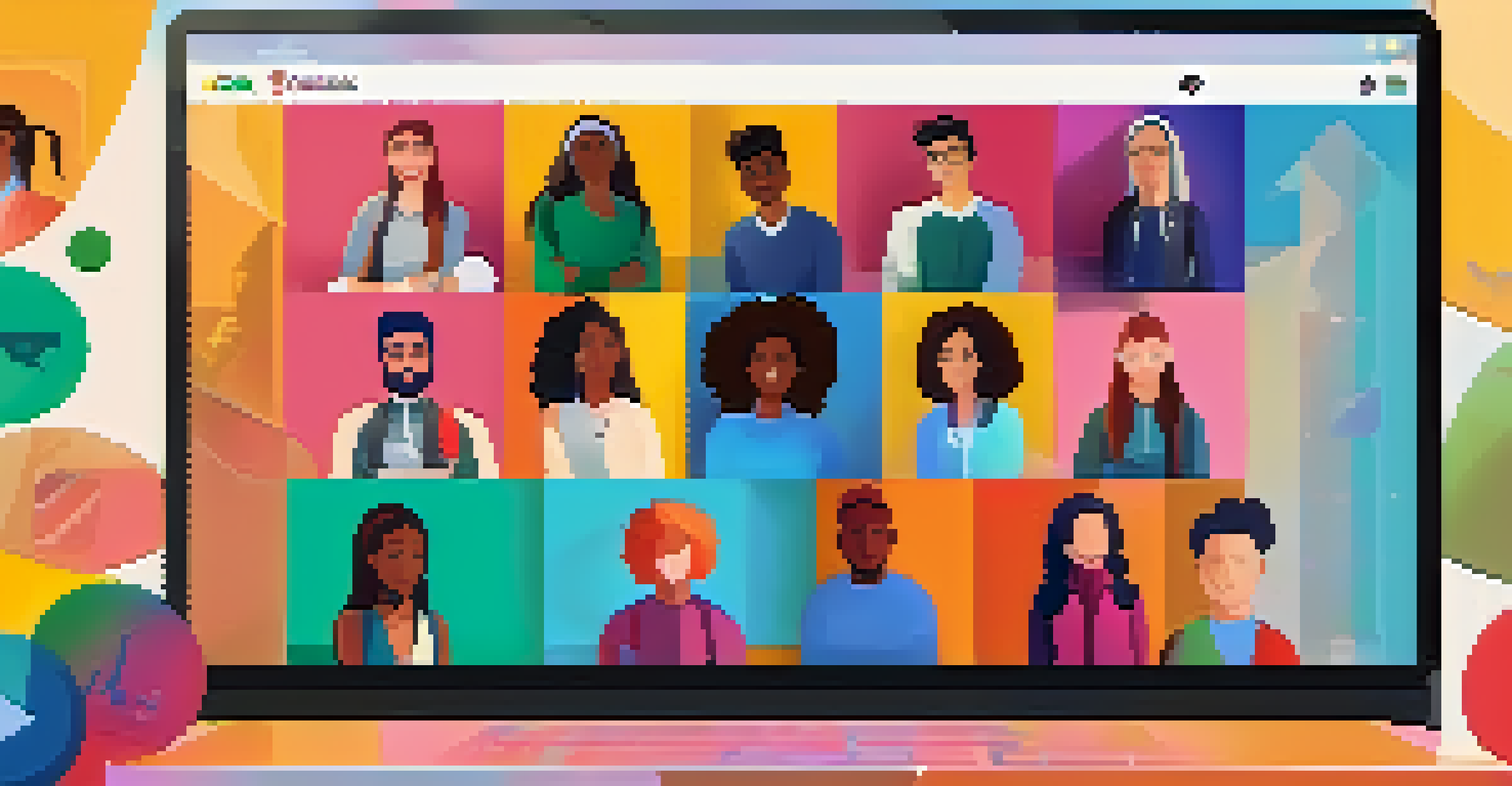Asynchronous Learning: Building Community and Connection

Understanding Asynchronous Learning and Its Benefits
Asynchronous learning allows students to engage with course materials at their own pace, rather than adhering to a fixed schedule. This flexibility can be a game-changer for many learners, especially those balancing work, family, and education. With the rise of online courses, this learning style has become increasingly popular, offering access to education that would otherwise be out of reach for some.
Education is the most powerful weapon which you can use to change the world.
One of the biggest advantages of asynchronous learning is that it caters to diverse learning styles. Visual learners can take their time with videos, while readers can delve deeply into text-based resources. This variety not only enhances understanding but also keeps students engaged and motivated to learn.
Moreover, asynchronous learning creates a unique space for students to reflect on their learning before responding to discussions. This can lead to more thoughtful contributions and deeper conversations, fostering a sense of community even when participants are miles apart.
Creating a Sense of Community in Online Settings
Building community in asynchronous learning can sometimes feel challenging, but it's essential for a positive experience. Educators can encourage interactions through discussion boards, group projects, and peer feedback. These tools help students connect, share ideas, and support each other, creating a sense of belonging.

Another effective strategy is to establish clear communication norms from the outset. When students know how and when to engage with their peers and instructors, they’re more likely to participate actively. Regular check-ins or prompts can also encourage students to share their experiences and insights, reinforcing community ties.
Flexibility Enhances Learning Experience
Asynchronous learning allows students to engage with course materials at their own pace, accommodating diverse schedules and learning styles.
Incorporating icebreakers and social activities into the curriculum can further enhance community feeling. These activities help students learn about one another and build relationships that extend beyond academic discussions, making the online environment feel more personal.
The Role of Technology in Fostering Connection
Technology plays a crucial role in connecting students in asynchronous learning environments. Platforms like discussion forums, chat rooms, and video conferencing tools make it easier for students to share ideas and collaborate. This technological integration can transform isolated learning experiences into dynamic interactions.
The beautiful thing about learning is that no one can take it away from you.
Utilizing user-friendly tools is key to building these connections. For instance, platforms that allow for multimedia sharing can enhance discussions and make learning more interactive. By encouraging the use of videos, podcasts, and graphics, educators can create a more engaging environment that resonates with various learners.
Moreover, technology can help track student engagement and participation, allowing instructors to provide targeted support where needed. This data can inform instructional adjustments that promote a more inclusive learning community, ensuring that every student feels valued and connected.
Encouraging Interaction Through Structured Activities
Structured activities are vital in promoting interaction among students in asynchronous courses. Assigning collaborative projects or group discussions can motivate students to engage with one another actively. These activities not only enhance learning but also strengthen relationships among peers.
Consider implementing peer review processes where students critique each other’s work. This not only builds critical thinking skills but also fosters a sense of accountability within the community. When students know their contributions matter, they’re more likely to participate wholeheartedly.
Community Building is Essential
Creating a sense of community through structured activities and clear communication fosters connections and enhances student engagement in online settings.
Additionally, creating themed discussion threads can spark interest and encourage diverse perspectives. Topics that resonate with students' experiences can lead to richer conversations and a deeper sense of connection, ultimately enhancing the overall learning experience.
Building Trust in Online Learning Communities
Trust is foundational in any community, and it's especially important in asynchronous learning environments. Establishing a safe space where students feel comfortable sharing their thoughts and experiences can significantly enhance engagement. Educators can foster trust by being approachable and responsive to students’ needs.
Clear guidelines and expectations can also help build trust. When students know what’s expected of them and feel supported in their learning journey, they’re more likely to take risks and participate actively. Open lines of communication allow students to voice concerns, further strengthening the community.
Lastly, recognizing individual contributions can bolster trust and encourage continued participation. Acknowledging students' efforts, whether through feedback or public recognition, helps build a supportive atmosphere where everyone feels valued.
The Importance of Feedback in Building Community
Feedback is a powerful tool in asynchronous learning, serving as a catalyst for both personal growth and community building. When students receive constructive feedback, they feel more connected to their instructors and peers, understanding that their contributions matter. This connection can motivate them to engage more deeply in discussions and activities.
Creating a culture of feedback involves encouraging not only instructor comments but also peer feedback. When students evaluate each other’s work, they learn to appreciate diverse perspectives and develop collaborative skills. This reciprocal feedback loop enhances community spirit as students support one another’s growth.
Feedback Strengthens Connections
Timely and constructive feedback not only promotes personal growth but also builds a supportive atmosphere that encourages active participation among students.
Furthermore, timely and specific feedback can help students stay on track and feel more invested in their learning. When they see their progress acknowledged, it fosters a positive environment where everyone feels encouraged to participate and contribute.
Celebrating Achievements to Strengthen Connections
Celebrating achievements, big and small, can significantly strengthen connections within an asynchronous learning community. Recognizing milestones, whether it's completing a course or mastering a challenging topic, fosters a sense of accomplishment and belonging. This recognition helps create a positive atmosphere where students feel encouraged to continue their learning journey.
Incorporating celebration moments into the course structure can also promote community bonding. For instance, end-of-course reflections or recognition ceremonies can serve as platforms for students to share their experiences and insights. This not only highlights individual achievements but also reinforces the collective journey of the group.

Moreover, encouraging students to share their personal successes and challenges can deepen connections. When students see that others are navigating similar paths, it creates empathy and solidarity, ultimately building a stronger learning community.
Conclusion: The Future of Community in Asynchronous Learning
Asynchronous learning is evolving, and with it, the ways we build community and connection are also changing. Embracing innovative strategies and leveraging technology can create engaging learning environments that prioritize connection. The focus on community will continue to shape the future of education, making it more inclusive and accessible.
As we reflect on the importance of connection in learning, it’s clear that fostering a supportive community is essential for student success. Educators play a crucial role in nurturing these relationships, ensuring that every learner feels valued and heard. By prioritizing community, we empower students to achieve their goals while building meaningful connections.
Ultimately, the future of asynchronous learning lies in our ability to create vibrant communities that bring students together, regardless of distance. As we navigate this landscape, let’s embrace the opportunities to connect, collaborate, and celebrate our learning journeys together.